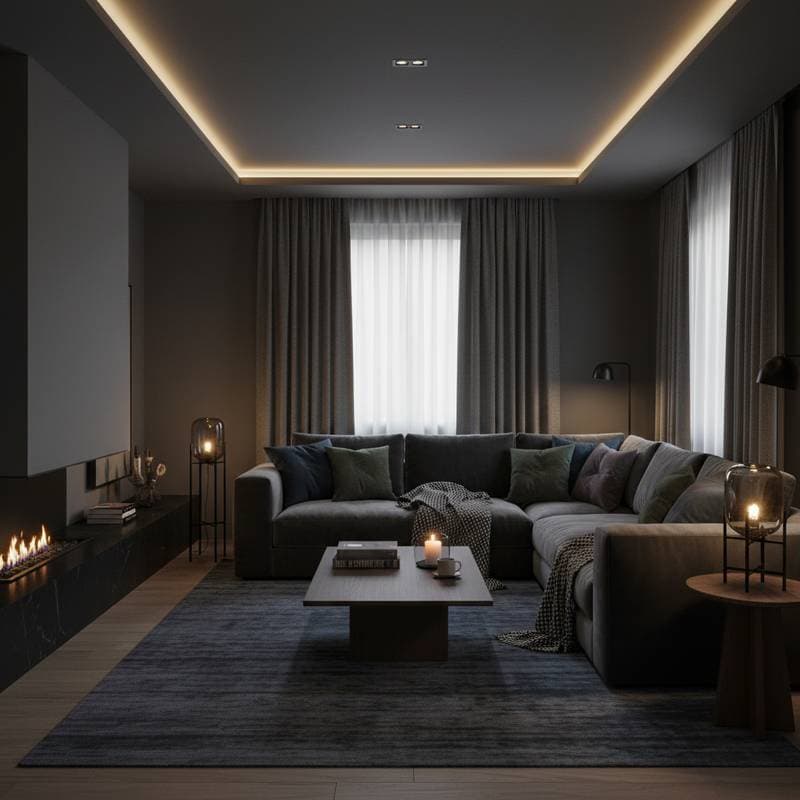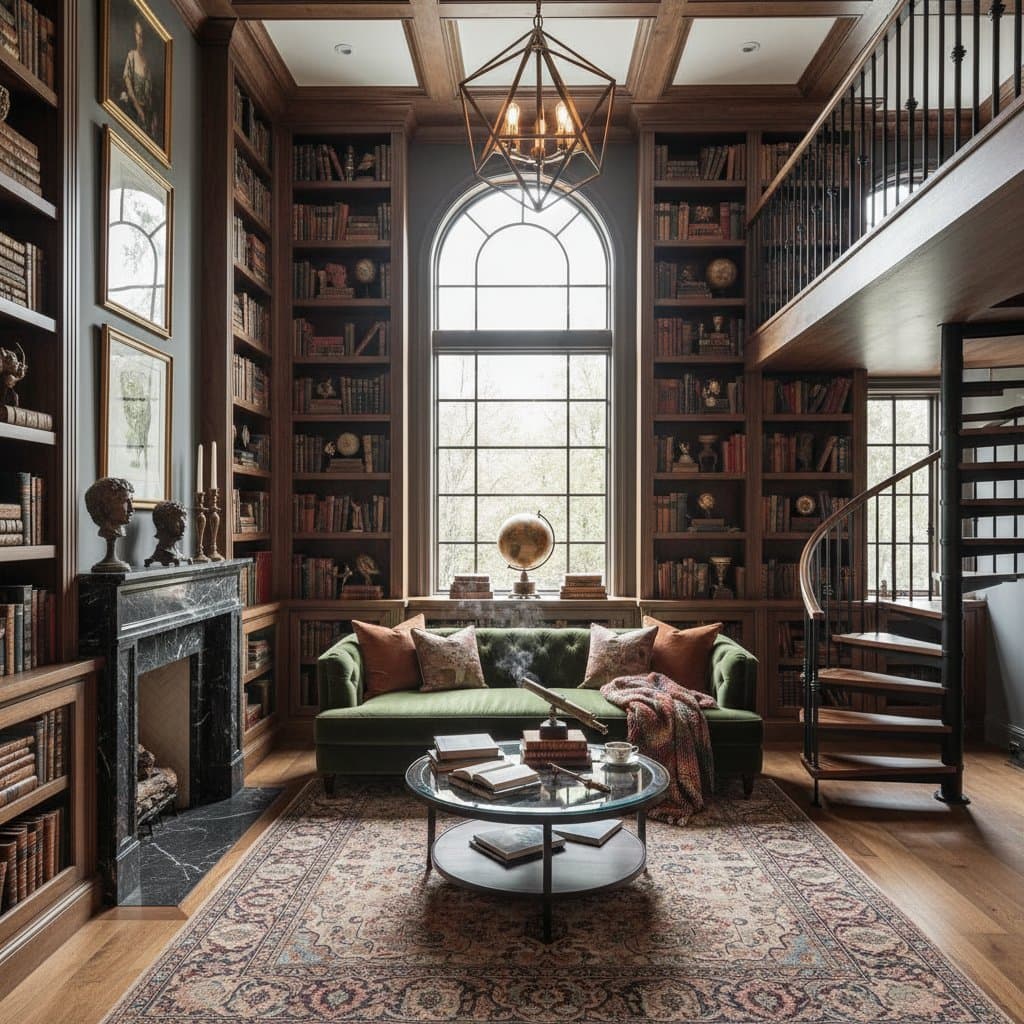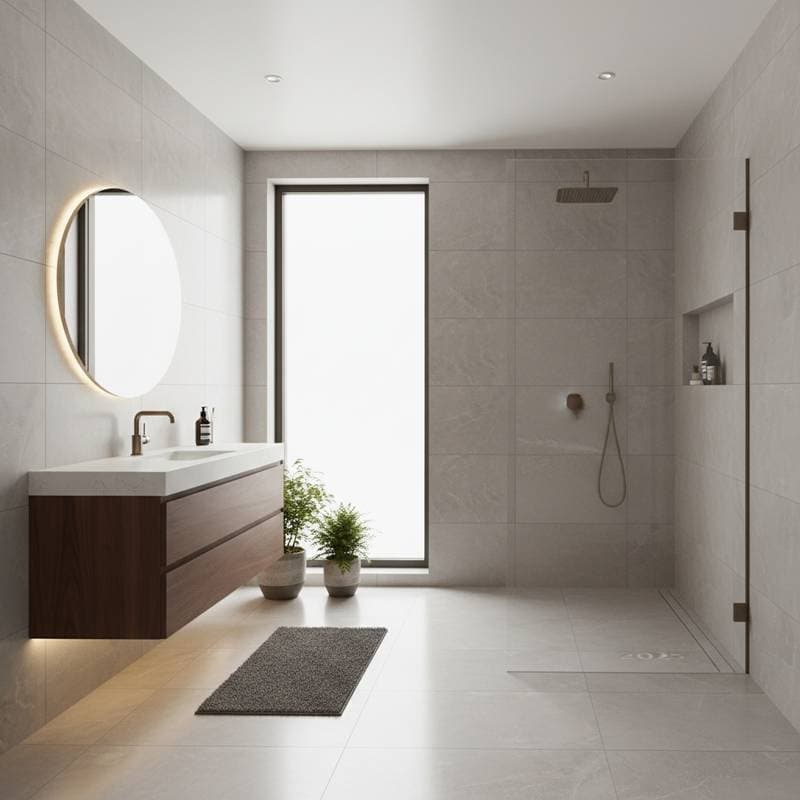Why Moody Dark Interiors Define 2025 Cocooning
Dark interiors have returned with enduring appeal. This moody aesthetic shapes the cocooning trend, blending comfort with distinctive character. Deep colors, subdued lighting, and varied textures form environments that provide security, stability, and subtle drama. Ultimately, these designs convert living spaces into personal retreats that envelop occupants.
Understanding Moody Dark Interiors
Moody interiors emphasize shadows and contrasts rather than illumination. Base tones include charcoal, espresso, navy, or forest green. Surfaces feature matte finishes, plush materials, and minimal lighting. Rather than resisting darkness, these spaces embrace it to foster tranquility over dreariness.
Cocooning represents an inward focus on solace, seclusion, and emotional relief. In interior design, it manifests through stratified illumination, rich pigments, and sensory elements. Moody dark rooms align seamlessly, offering an encompassing sensation that dampens external distractions and encourages relaxation.
Reasons for the Shift Toward Darker Spaces
Homes once served primarily as departure points. Today, they function as secure refuges. Individuals seek designs that promote privacy and personalization. Dark walls paired with gentle lighting achieve this effect efficiently. They render compact areas purposeful rather than confined. Additionally, these setups conceal everyday disorder and capture attention in visual media, sustaining their popularity.
Psychological factors contribute significantly. Gentle obscurity promotes serenity by signaling protection and moderating mental activity. This proves essential amid a hectic, noisy world. The trend prioritizes restoration over mere style.
Steps to Design a Moody Dark Interior
Transformation requires no complete overhaul. Initiate with modest changes and expand gradually.
Select a Rich Base Color
Opt for a deep neutral or subdued shade, such as charcoal, deep olive, or ink blue. Evaluate samples under both natural and artificial conditions. Reserve pure black for applications balanced by varied textures and warm elements.
Incorporate Textural Layers
Textures prevent monotony in shadowed settings. Combine velvet, linen, wool, and wood. Include matte metals or stone to diffuse light softly. Consider tactile qualities alongside visual ones.
Manage Illumination Effectively
Employ warm, subdued sources. Prioritize wall sconces, table lamps, and dimmers over ceiling fixtures. Select bulbs that emit soft warmth, avoiding stark white tones. Create directed pools of light to direct attention.
Anchor with Natural Elements
Incorporate wood, clay, leather, and rattan to infuse warmth into dark schemes. These materials develop patina over time. A walnut table or aged leather seating provides respite in dim surroundings.
Introduce Subtle Contrasts
Position pale artwork or brass elements against dark backdrops for emphasis. Apply contrasts judiciously to maintain a refined, uncluttered appearance.
Conceal Clutter
Dark environments appear optimal with clear surfaces. Utilize enclosed storage and sparse ornamentation. Ensure every item serves a purposeful role, promoting serenity without sterility.
Cost Considerations
Expenses vary based on scope. Basic painting remains economical, while enhancements in lighting and materials accumulate.
| Task | Typical Cost | Influencing Factors |
|---|---|---|
| Wall and trim painting | $200 to $800 per room | Room dimensions, paint grade, professional versus self-application |
| Lighting enhancements | $300 to $1,500 | Fixture complexity, installation charges |
| Furniture and textiles | $1,000 to $5,000 | Material standards, customization |
| Complete redesign | $3,000 to $10,000+ | Consultation fees, material selections, workforce |
Regional differences apply. Premium options and expert guidance elevate totals. Self-painting or vintage sourcing reduces outlays.
Timeline Expectations
A single room repaint requires one to two days. Integrating lighting or furnishings may extend to a week. Comprehensive overhauls span a month. Decision processes often consume the most time, surpassing physical work.
Accelerate by previewing colors via sample panels. Procure lighting fixtures promptly to circumvent delays. Coordinate trades like electricians and painters to minimize downtime.
DIY Versus Professional Approach
Pursue DIY When
- Repainting walls or refreshing accessories.
- Enjoying minor tasks such as lamp or curtain replacements.
- Possessing availability to experiment with shades and illumination.
Engage Professionals When
- Installing recessed lighting or custom cabinetry.
- Requiring electrical or structural modifications.
- Preparing for property sale or lease with flawless execution.
Experts ensure harmony in color warmth, material variety, and spatial balance, averting cavernous results. Skilled applicators achieve even coats on bold hues, where imperfections appear prominently.
Essential Tools and Materials
- Paintbrushes, rollers, and masking tape.
- Protective sheets and primers suited for deep pigments.
- Warm-toned LED bulbs in soft white or amber.
- Portable lamps, wall-mounted fixtures, or adjustable controls.
- Varied textiles including rugs and cushions.
- Organic accents like wood pieces.
- Framed artwork, reflective surfaces, and minor metallic touches.
These items correspond to specific phases: application tools for coloration, illumination components for ambiance, fabrics for dimension, and accents for focal points.
Regional and Environmental Factors
Local weather influences perception. In bright locales, intense shades counteract excessive sunlight and warmth. In overcast or chilly areas, they enhance coziness. Employ warm undertones for cooler climates; opt for muted grays or blues in intense light zones.
Regulations govern electrical alterations. Permanent installations demand certified technicians. Verify requirements prior to new wiring.
Advantages and Drawbacks
| Aspect | Benefits | Limitations |
|---|---|---|
| Atmosphere | Serene, private, stabilizing | Potentially oppressive if excessive |
| Upkeep | Masks stains and aging | Attracts visible dust on gloss |
| Illumination | Inviting and enveloping | Demands multifaceted sources |
| Longevity | Enduring and striking | Challenging to reverse or brighten |
Balance remains crucial. Integrate reflective features like mirrors or light fabrics in each area to temper intensity.
Psychological and Scientific Basis
Deep tones absorb illumination, decelerating visual intake and mitigating stress. Warm variants like auburn evoke reassurance; cooler ones such as navy induce composure. Combined with sensory materials, these elements amplify serenity. Spaces gain vitality while remaining restful.
Professionals term this visual mass. Substantial shades establish solidity, while pale ones elevate. Cocooning leverages density for psychological refuge, akin to an intangible embrace.
Optimized Lighting Techniques
Illumination determines depth and comfort in shadowed rooms.
Stratify Sources
- Ambient layers provide baseline radiance via diffused fixtures.
- Functional lights target activities, such as desk or shelf illumination.
- Highlighting accents showcase details like artwork or foliage.
Vary elevations among sources to sustain visual interest and prevent uniformity.
Select Appropriate Bulbs
Target 2,700 to 3,000 Kelvin for flattering warmth against deep walls. Harsh cool lights undermine the intended atmosphere.
Implement Controls
Dimmers allow adaptation to daily rhythms. Brighter settings suit tasks; subdued ones aid repose. This approach conserves power and eases visual strain.
Furniture Selection and Arrangement
Favor low-slung, touchable pieces. Substantial couches, curved seats, and thick carpets secure the foundation. Shun high-gloss surfaces that scatter light harshly; prefer subdued or textured finishes.
Position groupings intimately. Cocooning emphasizes closeness for dialogue and ease, not exhibition. Employ flexible dividers like drapes to delineate inviting areas.
Preventing Overly Dim Results
Incorporate reflective planes sparingly. Mirrors, metal trim, or neutral art disrupt uniformity. Introduce low-light tolerant greenery like snake plants for vitality.
Consider overhead treatment. Lighter ceilings preserve perceived height against dark walls. For full immersion, pair uniform darkness with robust layered lights.
Sustainable Practices
These designs complement eco-conscious choices. Organic fibers and salvaged timber harmonize with palettes. Subdued finishes typically involve milder compounds than sheens.
Repurpose existing items by refinishing in deeper shades. Select low-emission paints for healthier air. Prioritize natural wools or cottons over synthetics for superior feel and durability.
Guidance on Professional Assistance
Consult designers for equilibrium in sampling and tone selection tailored to light patterns. Electricians handle circuit additions or controls. Contractors manage structural shifts, securing compliance.
Adhere to permitting for wiring. Unauthorized modifications risk coverage denials in incidents. Confirm standards before permanent changes.
Seasonal Adjustments
Adapt to weather fluctuations. Boost artificial glow and add insulating layers in colder months. In warmer periods, incorporate breathable linens and daylight exposure.
Exchange textiles or displays for tonal shifts without structural alterations. In moist climates, employ moisture control to avert concealed damage on shaded surfaces.
Practical Decision Framework
| Scenario | Recommendation | Rationale |
|---|---|---|
| Compact space lacks vibrancy | Apply deep shade to one wall | Enhances dimension sans constriction |
| Expansive area feels stark | Zone with a bold color block | Establishes warmth and boundaries |
| Desire intensity without dreariness | Employ medium charcoal plus warm lights | Offers versatility and leniency |
| Temporary changes in rentals | Install dark window treatments or floor coverings | Achieves impact reversibly |
Frequent Pitfalls and Remedies
Common errors include stark lighting that disrupts ambiance, neglecting vertical scale to compress height, excess items that dilute intent, and omitting textures that flatten shadows.
Correct with warm sources, streamlined selections, and enriched surfaces. These adjustments resolve most issues efficiently.
Expert Recommendations
- Test pigments under site-specific lighting.
- Anchor with a primary deep shade supported by two to three muted complements.
- Include reflective or metallic highlights.
- Stack fabric varieties for richness 5. Prioritize adjustable controls and superior illumination.
Such elements distinguish compelling from confining designs.
The Synergy of Cocooning and Shadow
Cocooning seeks mental reprieve, rendering residences as havens. Dark schemes complement by shielding from sensory overload, fostering secure enclosure. Residents rejuvenate within rather than fleeing outward. Pigment intensity and light orchestration bolster cognitive calm.
Formerly, vivid areas symbolized vigor and achievement. Now, subdued profiles signify tranquility and autonomy. This evolution reflects broader societal values of seclusion, nurture, and individualized comfort.
Implementing Your Vision
Commence in a single space. Introduce a profound wall treatment and ambient lamp. Layer with a fibrous floor covering or shaded textile. Observe effects over days, noting shifts in atmosphere and concentration. Progressive refinement personalizes the sanctuary, ensuring each addition enhances belonging.
When fabrics catch subtle rays, surfaces temper harshness, and quiet prevails, success emerges. Moody darkness transcends fleeting style; it constructs enduring repose.








